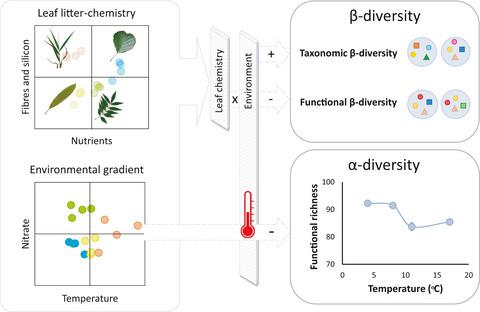当前位置:
X-MOL 学术
›
Glob. Change Biol.
›
论文详情
Our official English website, www.x-mol.net, welcomes your
feedback! (Note: you will need to create a separate account there.)
Elevated temperature may reduce functional but not taxonomic diversity of fungal assemblages on decomposing leaf litter in streams
Global Change Biology ( IF 10.8 ) Pub Date : 2021-10-15 , DOI: 10.1111/gcb.15931 Encarnación Fenoy 1, 2 , Arunava Pradhan 3, 4 , Cláudia Pascoal 3, 4 , Juan Rubio-Ríos 1, 2 , Daniela Batista 3, 4 , Francisco J Moyano-López 1 , Fernanda Cássio 3, 4 , J Jesús Casas 1, 2
Global Change Biology ( IF 10.8 ) Pub Date : 2021-10-15 , DOI: 10.1111/gcb.15931 Encarnación Fenoy 1, 2 , Arunava Pradhan 3, 4 , Cláudia Pascoal 3, 4 , Juan Rubio-Ríos 1, 2 , Daniela Batista 3, 4 , Francisco J Moyano-López 1 , Fernanda Cássio 3, 4 , J Jesús Casas 1, 2
Affiliation

|
Mounting evidence points to a linkage between biodiversity and ecosystem functioning (B-EF). Global drivers, such as warming and nutrient enrichment, can alter species richness and composition of aquatic fungal assemblages associated with leaf-litter decomposition, a key ecosystem process in headwater streams. However, effects of biodiversity changes on ecosystem functions might be countered by the presumed high functional redundancy of fungal species. Here, we examined how environmental variables and leaf-litter traits (based on leaf chemistry) affect taxonomic and functional α- and β-diversity of fungal decomposers. We analysed taxonomic diversity (DNA-fingerprinting profiles) and functional diversity (community-level physiological profiles) of fungal communities in four leaf-litter species from four subregions differing in stream-water characteristics and riparian vegetation. We hypothesized that increasing stream-water temperature and nutrients would alter taxonomic diversity more than functional diversity due to the functional redundancy among aquatic fungi. Contrary to our expectations, fungal taxonomic diversity varied little with stream-water characteristics across subregions, and instead taxon replacement occurred. Overall taxonomic β-diversity was fourfold higher than functional diversity, suggesting a high degree of functional redundancy among aquatic fungi. Elevated temperature appeared to boost assemblage uniqueness by increasing β-diversity while the increase in nutrient concentrations appeared to homogenize fungal assemblages. Functional richness showed a negative relationship with temperature. Nonetheless, a positive relationship between leaf-litter decomposition and functional richness suggests higher carbon use efficiency of fungal communities in cold waters.
中文翻译:

升高的温度可能会降低分解溪流中落叶的真菌组合的功能多样性,但不会降低分类多样性
越来越多的证据表明生物多样性与生态系统功能 (B-EF) 之间存在联系。全球驱动因素,例如变暖和养分富集,可以改变与枯叶落叶分解相关的水生真菌组合的物种丰富度和组成,这是上游河流中的一个关键生态系统过程。然而,生物多样性变化对生态系统功能的影响可能会被真菌物种的高功能冗余所抵消。在这里,我们研究了环境变量和落叶性状(基于叶子化学)如何影响真菌分解者的分类和功能 α 和 β 多样性。我们分析了来自四个不同溪水特征和河岸植被的亚区域的四种落叶物种中真菌群落的分类多样性(DNA 指纹图谱)和功能多样性(群落级生理图谱)。我们假设,由于水生真菌之间的功能冗余,增加河流水温和养分会改变分类多样性而不是功能多样性。与我们的预期相反,真菌分类多样性在各次区域的河流水特征中变化不大,而是发生了分类单元替换。总体分类学 β 多样性比功能多样性高四倍,表明水生真菌之间存在高度的功能冗余。升高的温度似乎通过增加 β 多样性来提高组合的独特性,而营养浓度的增加似乎使真菌组合均质化。功能丰富度与温度呈负相关。尽管如此,凋落物分解与功能丰富度之间的正相关表明,冷水中真菌群落的碳利用效率更高。
更新日期:2021-12-03
中文翻译:

升高的温度可能会降低分解溪流中落叶的真菌组合的功能多样性,但不会降低分类多样性
越来越多的证据表明生物多样性与生态系统功能 (B-EF) 之间存在联系。全球驱动因素,例如变暖和养分富集,可以改变与枯叶落叶分解相关的水生真菌组合的物种丰富度和组成,这是上游河流中的一个关键生态系统过程。然而,生物多样性变化对生态系统功能的影响可能会被真菌物种的高功能冗余所抵消。在这里,我们研究了环境变量和落叶性状(基于叶子化学)如何影响真菌分解者的分类和功能 α 和 β 多样性。我们分析了来自四个不同溪水特征和河岸植被的亚区域的四种落叶物种中真菌群落的分类多样性(DNA 指纹图谱)和功能多样性(群落级生理图谱)。我们假设,由于水生真菌之间的功能冗余,增加河流水温和养分会改变分类多样性而不是功能多样性。与我们的预期相反,真菌分类多样性在各次区域的河流水特征中变化不大,而是发生了分类单元替换。总体分类学 β 多样性比功能多样性高四倍,表明水生真菌之间存在高度的功能冗余。升高的温度似乎通过增加 β 多样性来提高组合的独特性,而营养浓度的增加似乎使真菌组合均质化。功能丰富度与温度呈负相关。尽管如此,凋落物分解与功能丰富度之间的正相关表明,冷水中真菌群落的碳利用效率更高。











































 京公网安备 11010802027423号
京公网安备 11010802027423号